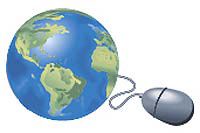Those of you who often surf the Internet have probably heard or seen the word “URL” and wondered what it meant. Actually, URL is an acronym that stands for “Universal Resource Locator.” Fundamentally, URLs specify the location of an electronic resource (generally speaking, an Internet resource). Essentially, a URL is an address. Usually, however, URLs point to web sites, like http://www.ecprogress.com/ or http://www.sunad.com/board/.
Every URL has a prefix that defines what protocol must be used to access the resource. This prefix includes a colon and two forward slashes to the right of the protocol indicator (like http:// or ftp://). A protocol is a common means of communication, (a language). The most common protocol used in URLs is HTTP. HTTP stands for “Hyper-text Transfer Protocol” and is used when viewing web pages.
To view any web page on the Internet, your computer must be able to speak the HTTP protocol. A browser program (like Microsoft Internet Explorer, Netscape Navigator, Mozilla Firefox, etc.) gives your computer the ability to view web pages because it speaks the HTTP protocol.
Because HTTP is the most commonly used protocol on the Internet, most browsers will assume any URL it’s given that lacks protocol information is HTTP.
For example, if you type www.sunad.com into your browser’s address bar, it will assume you meant http://www.sunad.com/ and requests the web page located at that address.
When website communication needs to be encrypted, your browser will use Secure HTTP (denoted by https://), which makes sure communication is scrambled so only the appropriate parties can read it!
There are other protocols other than HTTP that are used on the Internet, however. One of the most useful and common ones is FTP, which stands for “File Transfer Protocol.” FTP, as the name suggests, allows files to be transferred to and from different hosts (computers). A typical FTP URL might look like this: ftp://office.ecprogress.com/.
Now you a little bit about what that http:// in your browser’s address bar is all about!
Have comments or suggestions for a weekly Tech Tips article? Send an email to webmaster@sunad.com.
What’s in an Internet address?

